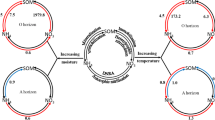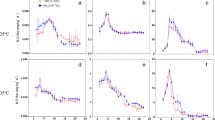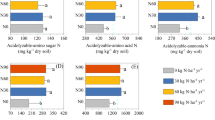Abstract
Quantifying the gross rates of individual nitrogen (N) processes is critical for understanding the availability, retention and loss of N and its eco-environmental impacts in agricultural ecosystems. Here, we carried out a 15N tracing study to quantify the influence of soil moisture on the gross rates of ten different N processes in two intensively managed fluvo-aquic soils. Results showed that the gross N mineralization rates were insensitive to changes in soil moisture, ranging from 40 to 120% water-filled pore space (WFPS). Contrarily, the gross ammonium (NH4+) immobilization rates increased exponentially with elevated soil moisture. Specifically, under high soil moisture conditions (i.e., 90–120%WFPS), the gross NH4+ immobilization rates (4.04 ± 0.83 and 0.88 ± 0.28 mg N kg− 1d− 1 for the two soils, respectively) were nearly four times higher than those under medium or low moisture conditions (i.e., 40–80%WFPS). Meanwhile, the high WFPS reduced the gross autotrophic nitrification rates (5.92 ± 2.15 and 12.31 ± 3.83 mg-N kg− 1d− 1 for the two soils, respectively) to only one-third to one-half of those that were observed under medium or low WFPS. By contrast, the rates of nitrate (NO3−) immobilization increased in one soil whereas they decreased in another under high moisture conditions, and the other N processes (including heterotrophic nitrification and dissimilatory nitrate reduction to ammonium (DNRA)) were negligible throughout the different WFPS. Overall, our results suggest that under highly saturated conditions, the increase in microbial NH4+ immobilization and decrease in autotrophic nitrification are critical for N retention in the fluvo-aquic soils. These findings provide valuable insights into potential alterations in soil N retention or loss under future climate change scenarios, where more intensive irrigation and extreme rainfall events are anticipated.






Similar content being viewed by others
References
Accoe F, Boeckx P, Busschaert J, Hofman G, Van Cleemput O (2004) Gross N transformation rates and net N mineralisation rates related to the C and N contents of soil organic matter fractions in grassland soils of different age. Soil Biol Biochem 3612:2075–2087
Basu NB, Van Meter KJ, Byrnes DK, Van Cappellen P, Brouwer R, Jacobsen BH, Jarsjö J, Rudolph DL, Cunha MC, Nelson N, Bhattacharya R, Destouni G, Olsen SB (2022) Managing nitrogen legacies to accelerate water quality improvement. Nat Geosci 152:97–105
Benbi DK, Richter J (2002) A critical review of some approaches to modelling nitrogen mineralization. Biol Fertil Soils 35:168–183
Billen G, Garnier J, Lassaletta L (2013) The nitrogen cascade from agricultural soils to the sea: modelling nitrogen transfers at regional watershed and global scales. Philos T R Soc B 3681621:20130123
Brooks P, Stark JM, Mcinteer B, Preston T (1989) Diffusion method to prepare soil extracts for automated nitrogen-15 analysis. Soil Sci Soc Am J 536:1707–1711
Butterbach-Bahl K, Baggs EM, Dannenmann M, Kiese R, Zechmeister-Boltenstern S (2013) Nitrous oxide emissions from soils: how well do we understand the processes and their controls? Philos T R Soc B 3681621:20130122
Chang BX, Yan ZF, Ju XT, Song XT, Li YW, Li SL, Fu PQ, Zhu-Barker X (2022) Quantifying biological processes producing nitrous oxide in soil using a mechanistic model. Biogeochemistry 159:1–14
Chen ZM, Ding WX, Xu YH, Müller C, Rütting T, Yu HY, Fan JL, Zhang JB, Zhu TB (2015) Importance of heterotrophic nitrification and dissimilatory nitrate reduction to ammonium in a cropland soil: evidences from a 15N tracing study to literature synthesis. Soil Biol Biochem 91:65–75
Chen YC, Wieder WR, Hermes AL, Hinckley ELS (2020) The role of physical properties in controlling soil nitrogen cycling across a tundra-forest ecotone of the Colorado Rocky Mountains, USA. CATENA 186:104369
Cheng Y, Wang J, Wang SQ, Zhang JB, Cai ZC (2014) Effects of soil moisture on gross N transformations and N2O emission in acid subtropical forest soils. Biol Fertil Soils 507:1099–1108
Di HJ, Cameron KC, Shen JP, Winefield CS, O’callaghan M, Bowatte S, He JZ (2009) Nitrification driven by bacteria and not archaea in nitrogen-rich grassland soils. Nat Geosci 29:621–624
Di HJ, Cameron KC, Podolyan A, Robinson A (2014) Effect of soil moisture status and a nitrification inhibitor, dicyandiamide, on ammonia oxidizer and denitrifier growth and nitrous oxide emissions in a grassland soil. Soil Biol Biochem 73:59–68
Elrys AS, Wang J, Metwally MS, Cheng Y, Zhang JB, Cai ZC, Chang SX, Müller C (2021) Global gross nitrification rates are dominantly driven by soil carbon-to-nitrogen stoichiometry and total nitrogen. Glob Chang Biol 2724:6512–6524
Fowler D, Coyle M, Skiba U, Sutton MA, Cape JN, Reis S, Sheppard LJ, Jenkins A, Grizzetti B, Galloway JN, Vitousek P, Leach A, Bouwman AF, Butterbach-Bahl K, Dentener F, Stevenson D, Amann M, Voss M (2013) The global nitrogen cycle in the twenty-first century. Philos T R Soc B 3681621:20130164
Gao WL, Fan CH, Zhang W, Li N, Liu HR, Chen M (2023) Heterotrophic nitrification of organic nitrogen in soils: process, regulation, and ecological significance. Biol Fertil Soils 593:261–274
Gibbs P, Barraclough D (1998) Gross mineralisation of nitrogen during the decomposition of leaf protein I (ribulose 1,5-diphosphate carboxylase) in the presence or absence of sucrose. Soil Biol Biochem 3013:1821–1827
Guntinas ME, Leiros MC, Trasar-Cepeda C, Gil-Sotres F (2012) Effects of moisture and temperature on net soil nitrogen mineralization: a laboratory study. Eur J Soil Sci 48:73–80
He MQ, Xin XL, Meng L, Yan XY, Zhao C, Cai ZC, Zhu AN, Zhang JB, Müller C (2021) Long-term appropriate N management can continuously enhance gross N mineralization rates and crop yields in a maize-wheat rotation system. Biol Fertil Soils 59:501–511
He XX, Dai SY, Meng L, He MQ, Wang XG, Cai ZC, Zhu B, Zhang JB, Nardi P, Müller C (2023) Effects of 18 years repeated N fertilizer applications on gross N transformation rates in a subtropical rain-fed purple soil. Appl Soil Ecol 189:104952
Hou HQ, Liu XM, Zhou WJ, Ji JH, Lan XJ, Lv ZZ, Liu YR, Zhang JB, Müller C (2022) N transformation mechanisms and N dynamics of organic fertilisers as partial substitutes for chemical fertilisers in paddy soils. J Soils Sediments 229:2516–2529
Hoyle FC, Murphy DV, Fillery IRP (2006) Temperature and stubble management influence microbial CO2-C evolution and gross N transformation rates. Soil Biol Biochem 381:71–80
Inselsbacher E, Wanek W, Strauss J, Zechmeister-Boltenstern S, Müller C (2013) A novel 15N tracer model reveals: plant nitrate uptake governs nitrogen transformation rates in agricultural soils. Soil Biol Biochem 57:301–310
Jansen-Willems AB, Zawallich J, Müller C (2022) Advanced tool for analysing 15N tracing data. Soil Biol Biochem 165:108532
Ju XT, Zhang C (2017) Nitrogen cycling and environmental impacts in upland agricultural soils in North China: a review. J Integr Agric 1612:2848–2862
Kiese R, Hewett B, Butterbach-Bahl K (2008) Seasonal dynamic of gross nitrification and N2O emission at two tropical rainforest sites in Queensland, Australia. Plant Soil 3091–2:105–117
Lan T, Han Y, Roelcke M, Nieder R, Cai ZC (2013) Processes leading to N2O and NO emissions from two different Chinese soils under different soil moisture contents. Plant Soil 3711:611–627
Lang M, Li P, Han XZ, Qiao YF, Miao SJ (2016) Gross nitrogen transformations in black soil under different land uses and management systems. Biol Fertil Soils 522:233–241
Linn D, Doran J (1984) Effect of water-filled pore space on carbon dioxide and nitrous oxide production in tilled and nontilled soils. Soil Sci Soc Am J 486:1267–1272
Mathieu O, Hénault C, Lévêque J, Baujard E, Milloux M-J, Andreux F (2006) Quantifying the contribution of nitrification and denitrification to the nitrous oxide flux using 15N tracers. Environ Pollut 1443:933–940
Müller C, Rütting T, Kattge J, Laughlin RJ, Stevens RJ (2007) Estimation of parameters in complex 15N tracing models by Monte Carlo sampling. Soil Biol Biochem 393:715–726
Putz M, Schleusner P, Rütting T, Hallin S (2018) Relative abundance of denitrifying and DNRA bacteria and their activity determine nitrogen retention or loss in agricultural soil. Soil Biol Biochem 123:97–104
Rice CW, Tiedje JM (1989) Regulation of nitrate assimilation by ammonium in soils and in isolated soil microorganisms. Soil Biol Biochem 214:597–602
Sadayappan K, Kerins D, Shen C, Li L (2022) Riverine nitrate concentrations predominantly driven by human, climate, and soil property in the Contiguous United States. Water Res 226:119295
Schleuss PM, Widdig M, Biederman LA, Borer ET, Crawley MJ, Kirkman KP, Seabloom EW, Wragg PD, Spohn M (2021) Microbial substrate stoichiometry governs nutrient effects on nitrogen cycling in grassland soils. Soil Biol Biochem 155:108168
Sebilo M, Mayer B, Nicolardot B, Pinay G, Mariotti A (2013) Long-term fate of nitrate fertilizer in agricultural soils. Proc Natl Acad Sci U S A 11045:18185–18189
Siebert S, Kummu M, Porkka M, Doell P, Ramankutty N, Scanlon BR (2015) A global data set of the extent of irrigated land from 1900 to 2005. Hydrol Earth Syst Sci 193:1521–1545
Smith KA (2017) Changing views of nitrous oxide emissions from agricultural soil: key controlling processes and assessment at different spatial scales. Eur J Soil Sci 682:137–155
Stockdale E, Hatch D, Murphy D, Ledgard S, Watson C (2002) Verifying the nitrification to immobilisation ratio (N/I) as a key determinant of potential nitrate loss in grassland and arable soils. Agronomie 227–8:831–838
Sun LF, Xia ZW, Sang CP, Wang X, Peng B, Wang C, Zhang JB, Müller C, Bai E (2019) Soil resource status affects the responses of nitrogen processes to changes in temperature and moisture. Biol Fertil Soils 556:629–641
Syakila A, Kroeze C (2011) The global nitrous oxide budget revisited. Greenhouse Gas Meas Manage 11:17–26
Tian HQ, Xu RT, Canadell JG, Thompson RL, Winiwarter W, Suntharalingam P, Davidson EA, Ciais P, Jackson RB, Janssens-Maenhout G, Prather MJ, Regnier P, Pan NQ, Pan SF, Peters GP, Shi H, Tubiello FN, Zaehle S, Zhou F, Arneth A, Battaglia G, Berthet S, Bopp L, Bouwman AF, Buitenhuis ET, Chang JF, Chipperfield MP, Dangal SRS, Dlugokencky E, Elkins JW, Eyre BD, Fu BJ, Hall B, Ito A, Joos F, Krummel PB, Landolfi A, Laruelle GG, Lauerwald R, Li W, Lienert S, Maavara T, Macleod M, Millet DB, Olin S, Patra PK, Prinn RG, Raymond PA, Ruiz DJ, Van Der Werf GR, Vuichard N, Wang JJ, Weiss RF, Wells KC, Wilson C, Yang J, Yao YZ (2020) A comprehensive quantification of global nitrous oxide sources and sinks. Nature 5867828:248–256
Tilman D, Cassman KG, Matson PA, Naylor R, Polasky S (2002) Agricultural sustainability and intensive production practices. Nature 4186898:671–677
Ting L, Yong H, Zucong C (2017) Comparison of gross N transformation rates in two paddy soils under aerobic condition. Pedosphere 271:112–120
Van Meter KJ, Van Cappellen P, Basu NB (2018) Legacy nitrogen may prevent achievement of water quality goals in the Gulf of Mexico. Science 3606387:427–430
Wan S, Lin YX, Fan JB, Hu HW, Zhang JB, Jin SS, Deng ML, Müller C, He JZ (2023) Different responses of nitrous oxide emissions to liming and manure amendment of an acidic ultisol are controlled by autotrophic and heterotrophic nitrification. Soil Biol Biochem 178:108960
Wang J, Wang L, Feng XJ, Hu HF, Cai ZC, Müller C, Zhang JB (2016) Soil N transformations and its controlling factors in temperate grasslands in China: a study from 15N tracing experiment to literature synthesis. J Geophys Res Biogeosci 12112:2949–2959
Wang YC, Ying H, Yin YL, Zheng HF, Cui ZL (2019) Estimating soil nitrate leaching of nitrogen fertilizer from global meta-analysis. Sci Total Environ 657:96–102
Wang H, Yan ZF, Ju XT, Song XT, Zhang JB, Li SL, Zhu-Barker X (2023a) Quantifying nitrous oxide production rates from nitrification and denitrification under various moisture conditions in agricultural soils: Laboratory study and literature synthesis. Front Microbiol 13:1110151
Wang J, Wu L, Xiao Q, Huang YP, Liu KL, Wu Y, Li DC, Duan YH, Zhang WJ (2023b) Long-term manuring enhances soil gross nitrogen mineralization and ammonium immobilization in subtropical area. Agric Ecosyst Environ 348:108439
Xin J, Liu Y, Chen F, Duan YJ, Wei GL, Zheng XL, Li M (2019) The missing nitrogen pieces: a critical review on the distribution, transformation, and budget of nitrogen in the vadose zone-groundwater system. Water Res 165:114977
Xing GX, Cao YC, Shi SL, Sun GQ, Du LJ, Zhu JG (2002) Denitrification in underground saturated soil in a rice paddy region. Soil Biol Biochem 3411:1593–1598
Yan ZF, Bond-Lamberty B, Todd-Brown KE, Bailey VL, Li SL, Liu CQ, Liu CX (2018) A moisture function of soil heterotrophic respiration that incorporates microscale processes. Nat Commun 91:2562
Yan ZF, Chang BX, Song XT, Wang GS, Shan J, Yang LQ, Li SL, Butterbach-Bahl K, Ju XT (2024) A microbial-explicit model with comprehensive nitrogen processes to quantify gaseous nitrogen production from agricultural soils. Soil Biol Biochem 189:109284
Yang QC, Tian HQ, Friedrichs MM, Hopkinson CS, Lu CQ, Najjar RG (2015) Increased nitrogen export from eastern North America to the Atlantic Ocean due to climatic and anthropogenic changes during 1901–2008. J Geophys Res Biogeosci 1206:1046–1068
Yang YJ, Zhang HP, Shan YH, Wang JJ, Qian XQ, Meng TZ, Zhang JB, Cai ZC (2019) Response of denitrification in paddy soils with different nitrification rates to soil moisture and glucose addition. Sci Total Environ 651:2097–2104
Yang Y, Jin ZN, Müller ND, Driscoll AW, Hernandez RR, Grodsky SM, Sloat LL, Chester MV, Zhu YG, Lobell DB (2023) Sustainable irrigation and climate feedbacks. Nat Food 48:654–663
Zaman M, Di HJ, Cameron KC, Frampton CM (1999) Gross nitrogen mineralization and nitrification rates and their relationships to enzyme activities and the soil microbial biomass in soils treated with dairy shed effluent and ammonium fertilizer at different water potentials. Biol Fertil Soils 292:178–186
Zhang JB, Zhu TB, Cai ZC, Müller C (2011) Nitrogen cycling in forest soils across climate gradients in Eastern China. Plant Soil 3421–2:419–432
Zhang JB, Zhu TB, Cai ZC, Qin SW, Müller C (2012) Effects of long-term repeated mineral and organic fertilizer applications on soil nitrogen transformations. Eur J Soil Sci 631:75–85
Zhang YC, Zhang JB, Meng TZ, Zhu TB, Müller C, Cai Z (2013) Heterotrophic nitrification is the predominant NO3- production pathway in acid coniferous forest soil in subtropical China. Biol Fertil Soils 497:955–957
Zhang JB, Cai ZC, Müller C (2018) Terrestrial N cycling associated with climate and plant-specific N preferences: a review. Eur J Soil Sci 693:488–501
Zhang YS, Pan BB, Lam SK, Bai E, Hou PF, Chen DL (2021) Predicting the ratio of Nitrification to immobilization to reflect the potential risk of Nitrogen loss Worldwide. Environ Sci Technol 5511:7721–7730
Zhu TB, Zhang JB, Cai ZC, Müller C (2011) The N transformation mechanisms for rapid nitrate accumulation in soils under intensive vegetable cultivation. J Soils Sediments 117:1178–1189
Zhu GD, Song XT, Ju XT, Zhang JB, Müller C, Sylvester-Bradley R, Thorman RE, Bingham I, Rees RM (2019) Gross N transformation rates and related N2O emissions in Chinese and UK agricultural soils. Sci Total Environ 666:176–186
Funding
This work was financially supported by the National Natural Science Foundation of China (42077009, 42221001), the Natural Science Foundation of Jiangsu Province (BK20211610), and by the Haihe Laboratory of Sustainable Chemical Transformations.
Author information
Authors and Affiliations
Contributions
All authors contributed to this study. H. W. conducted the experiments and wrote the first draft, and Z.Y. guided the experiments and completed the final draft. C.M., X.Z.B., X. S., X. J., Z. C., J. Z., and S. L. helped to improve the manuscript.
Corresponding author
Ethics declarations
Conflict of interest
The authors declare no conflict of interest.
Additional information
Publisher’s Note
Springer Nature remains neutral with regard to jurisdictional claims in published maps and institutional affiliations.
Electronic supplementary material
Below is the link to the electronic supplementary material.
Rights and permissions
Springer Nature or its licensor (e.g. a society or other partner) holds exclusive rights to this article under a publishing agreement with the author(s) or other rightsholder(s); author self-archiving of the accepted manuscript version of this article is solely governed by the terms of such publishing agreement and applicable law.
About this article
Cite this article
Wang, H., Yan, Z., Chen, Z. et al. Microbial ammonium immobilization promoted soil nitrogen retention under high moisture conditions in intensively managed fluvo-aquic soils. Biol Fertil Soils (2024). https://doi.org/10.1007/s00374-024-01831-y
Received:
Revised:
Accepted:
Published:
DOI: https://doi.org/10.1007/s00374-024-01831-y




